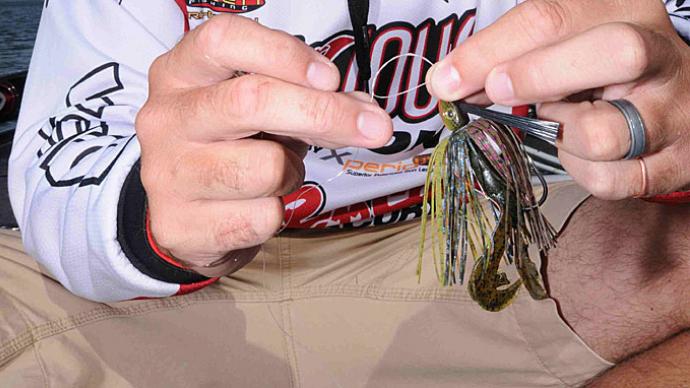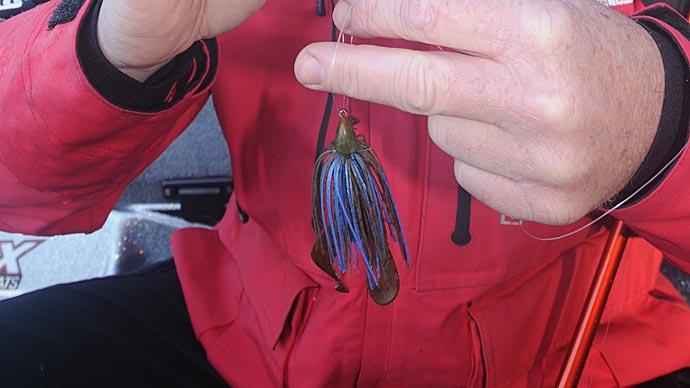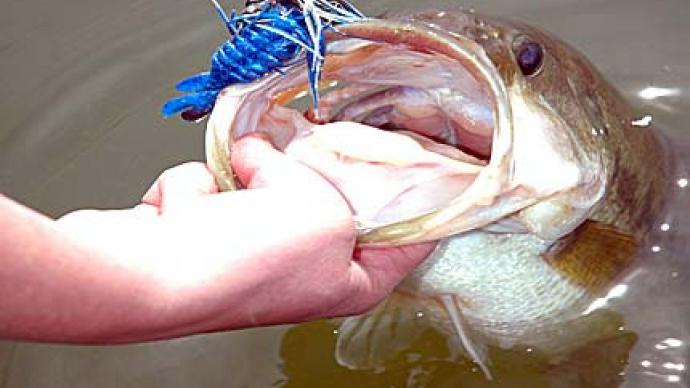
During late winter and throughout spring, bass on most southern waters seek out heavy cover on or near their spawning areas. Although worms and lizards take their share of lunkers during this period, no one lure compares to a lunker-producing lure like the jig. Therefore, if asked what lure will likely catch a trophy from January through March, most knowledgeable anglers will choose a jig.
The jig is a simple lure. It consists of a head, usually molded of lead on a hook with some feathers, hair, and skirt, with or without a weed guard. Most jig heads are molded to be roundish or bullet shaped. The shape of a jig without a trailer would suggest some sort of baitfish. However, with a trailer, the shape suggests anything from crawfish to frogs.
Hair and feather jigs have been used to catch bass for as long as anglers have been catching bass for sport or the table. Modern hair bucktail and feather Marabou jigs are used more in northern waters than southern waters.
Hair and feather jigs in the 1/16- to 1/4-ounce sizes are occasionally fished in some of the clearer, deeper lakes or rivers in the south. Usually, a light action spinning rod and reel combo with 6- to 10-pound fluorocarbon line works best.
Chartreuse, white, and black are among the most popular colors. Usually, the hair and feather jig is fished without a trailer. Instead, they are cast out and hopped back to the boat or fished vertically over deep water.
The rubber-legged jig was made famous in 1960 by the Arkie Lure Company (the Arkie Jig). The rubber skirt material was secured behind the head of the jig with a wire or band. During the 1980s, the rubber leg jig gave way to the silicone-skirted jig. Because silicone can be extruded in translucent colors, it works much better in clearer water. In addition, the silicone skirt does not stick together like rubber. The new silicone skirting material comes in virtually all colors and allows mixing or contrasting colors.
Some popular silicone jig colors include black, black-brown, black-blue, green pumpkin, brown-orange, black-red flake, green pumpkin, and watermelon. In addition, during the last few years, white has gained some popularity as a silicone jig color.
Silicone jigs come in sizes from 1/8- to over 1 ounce. The smaller 1/8-ounce size jig usually carries a 1/0 or 2/0 hook, while the 1/4- to 1-ounce jig usually comes equipped with a wide gap round bend 4/0 or 5/0 hook.
Most anglers fish the heavier 3/8- to 1-ounce jigs on 6-1/2 to 7-1/2-foot medium to heavy action rod and reel combos. Most newer jigs have a 2x strong hook. In addition to silicone, some skirts include a few strands of mylar to add flash. The mylar is most effective under low light conditions and during the night.
Experienced anglers always use pork or soft plastic trailer on the back of their jig. The trailer enhances the size, color, and action of the jig. Pork trailers are most effective in muddy water or at night, whereas soft plastic chunks or craws are more effective in clear-water situations. The trailer also adds bulk and softness to the jig, which may cause a bass to hold the jig for longer.
The pork frog has a bottom and a top side. The bottom or side that will face down is the fleshy or uneven side. The pork will run better if hooked with the fat or bottom side facing down. When using a pork or soft plastic chunk, putting a small piece of plastic worm on the hook's shank is best. This will keep the chunk from sliding down the hook and interrupting the point on a hook set.
Some jigs have rattles affixed to the hook's shank or on the skirt band. Generally, rattles are best during spring, on cloudy days, at night, or in muddy water. Some bass get turned on by the sound and ignore jigs without rattles. Some attractant seems to make a bass hold a jig for longer, as does a trailer with garlic or salt added.
The silicone-skirted jig is fished primarily in heavy brush or aquatic vegetation. Therefore, the weight of the jig you use depends primarily on the density of the brush or vegetation you are trying to penetrate. If you are fishing around brush or sparse brush or want a slow fall, a 1/4- to 3/8-ounce jig is likely sufficient. However, if you are trying to penetrate dense button bushes (buck brush), or matted hydrilla, you will probably have to go to a 1/2- to 1-ounce jig.
The type of trailer you choose will also impact how well the jig penetrates the heavy cover. A pork or soft plastic chunk will enter the brush more effectively than a craw worm. However, a craw worm will go through hydrilla better than a chunk. A small 4-inch craw will penetrate hydrilla better than a 6-inch craw or plastic chunk.
The terms pitching or flipping a jig are commonly used among bass anglers. These two techniques are used frequently when fishing a jig.
The flipping technique is primarily used around very heavy, shallow cover in muddy or off-colored water. This technique allows the angler to quickly move the jig into and out of heavy cover without casting. Since most flipping jigs are equipped with a 4/0 to 5/0 extra strong hook, a long 7-1/2-foot rod, and 20- to 30-pound fluorocarbon line or braid, and fluorocarbon leader can extract most bass from heavy cover.
This technique requires the angler to strike the fish with as much effort as possible and hold on while the fish plays down. Sometimes you have to go into the cover and get the fish out of the tangle of brush. You learn quickly when flipping a jig to do whatever is necessary, which will often be what everyone else is not doing.
If the water is clear, you may have to rely on pitching the jig instead of flipping it. The pitching technique generally takes a higher degree of skill but can be very rewarding if mastered correctly.
Fishing around hydrilla, milfoil, or other aquatic vegetation is one of the most popular ways to catch bass on jigs. Hydrilla on most southern waters grows best in the clearer parts of the water body or the lower half of a lake, typically closer to the dam. Hydrilla beds grow in water from two to three feet deep out to 15 to 20 feet of water, depending on water clarity and fluctuation.
Once you have located the hydrilla beds, it is essential to seek out prime structure such as ridges, points, humps, or creek beds. These topographic features will hold more bass than nonspecific areas with hydrilla.
During late winter and early spring, when the hydrilla is dormant, the outside edge where the vegetation stops growing will be where you want to fish. A light 1/4- to 3/8- ounce jig and salt chunk or craw will do best. Watermelon, green pumpkin, or black-blue will be the better colors. Use a medium action 6-1/2- to 7-foot rod with a 6.3:1 gear ratio reel and 14- to 17-pound test fluorocarbon and cast several feet into the grass. Hop the jig out until you no longer feel the grass. Stay away from the grass edge 20 or more feet and cast, or pitch, to the edge.
On warmer days during late winter and early spring, bass may relate to the shallower inside edge, so occasionally check by casting your jig to the inside edge.
During spring, the bass will move to the inside edge of the hydrilla - especially if the water does not get into the button bushes, willows, or cattails. You will have to cast your jig inside the grass line and work it into the inside edge of the hydrilla. If the water is two to six feet deep along this inside edge, bass will spawn and feed on the inside edge until late April or even May.
During late spring and summer, bass will again relate to the outside deeper hydrilla edge. During this period, and until the water gets cold, you can catch these fish by using 1/ 2- to 1-ounce jigs in the heavy mat along the outside edge of the hydrilla beds. The deeper the hydrilla, the longer bass will hold in this pattern.
The silicone jig is a deadly weapon for catching giant bass in heavy cover. It takes some time and practice to become proficient with a jig-and-pig, but once you have mastered it, you will be in on one of the top secrets of most successful bass anglers.




